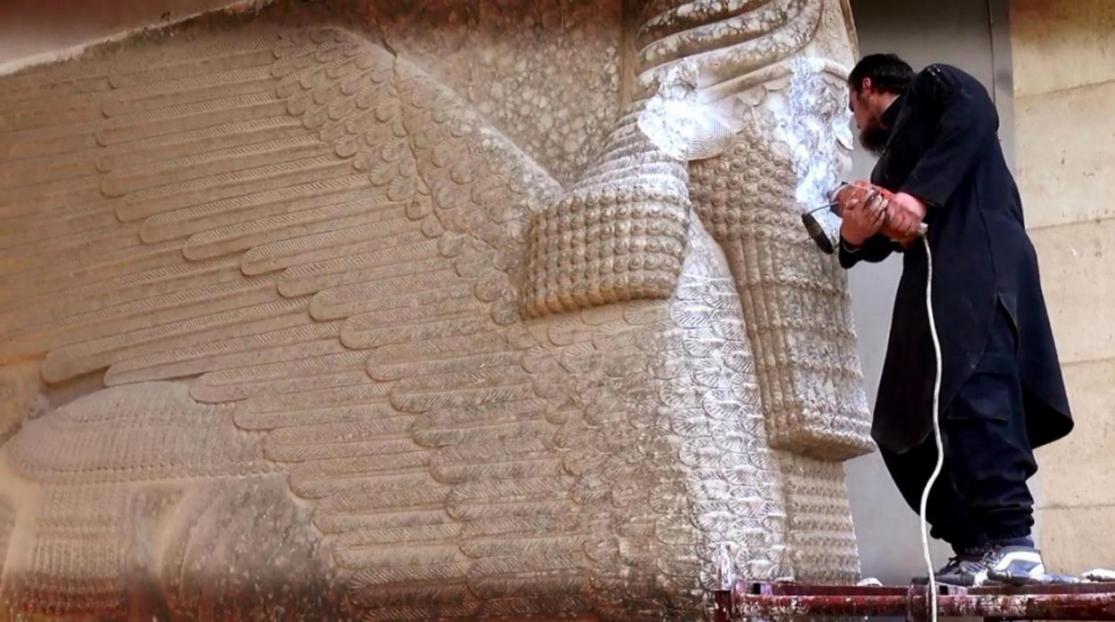The so-called Islamic State terrorist group - also known as Isis or Isil - recently released a video that showed its fighters ransacking Mosul’s central museum, destroying priceless artifacts thousands of years old. The group’s latest rampage - this time on art - threatens to upend millennia of coexistence in the cradle of civilization. In the footage, they are depicted pounding 3,000-year-old sculptures with hammers until they are completely shattered. Tens of militants are seen using ladders, hammers and drills to destroy every statue in the museum, including a winged-bull Assyrian protective deity dating back to the 7th century BC.
Ancient Persian heritage was also a salient feature of the Mosul Museum which was demolished by Isis fighters who did not see the artifacts fitting into their hateful ideology. Some Iranian archeologists told the Persian Shargh newspaper that the ancient Parthian Empire was the main target of Isis rampage.
Among the smashed objects, some belonged to the historic city of Hatra in the ancient Persian province of Khvarvaran from the Parthian Empire which ruled from 247 BC – 224 AD. Prominent artifacts destroyed were the marble statue of Sanatruq, a king of Hatra from the Parthian era; a statue of a Hatra priest; and an important mask.
‘’From the era of the Achaemenid Empire and particularly during the rule of the Parthians, what is modern Iraq now, it was part of the Persian civilization and even during the Sassanid Empire, Ctesiphon in today’s Iraq was their capital,’’ says Yaghoob Mohammadi, an archeologist from Avicenna University in Hamadan. Mohammadi adds that through the ages, west of today’s Iran was important to Persians because it was a gateway to interaction with the Romans. ‘’Back then, Euphrates was the border with the Romans and hence the importance of Mesopotamia to Iranians.’’
Hatra Excavations
During the Parthian rule, there were many local governments with some level of autonomy which were loyal to the central government and one of these states was Hatra which is 150 km south of today’s Mosul and received orders from the Parthians. Mohammadi says a significant portion of artifacts which were vandalized by Isis were from that era. The excavation of Hatra began 80 years ago by French and Iraqi archeologists and some of the most important artifacts recovered from those excavations were from the Parthian era now destroyed by Isis’ sledgehammers and eclectic drills, he explains. As Mohammadi puts it, ‘’Parthians are the main victims of the destruction.’’
‘’Another tragic aspect of Isis rampage is the destruction of symbols of religious tolerance from Hatra, which depicted a main square in the city with 14 temples from different religions including Judaism and Mithraism and other ancient religions,’’ says Mohammadi. He laments the fact that the symbols of coexistence between religions and cultures, a legacy from the Parthian era, were desecrated by some reactionary people who commit atrocities in the name of religion.
Significance
Ali Hojabri is another archeologist who says he has watched the Isis footage 16 times. He says some of the artifacts destroyed certainly belong to the Parthian era which were recovered by Iraqi archeologist Foad Safar from the ancient city of Hatra. The book containing information about the artifacts by the Iraqi scholar has been translated in Iran. “I hope that some of the destroyed objects were replicas of the original ones,’’ he prays.
Elaborating on the significance of the Hatra artifacts, Hojabri says ‘’all the recovered statues are life-size structures with stone pedestals, some of which are etched with Pahlavi script from the era of Parthians.’’
Iranian heritage in Iraq is not limited to Mosul antiquities. With a long history of Persian rule in Mesopotamia, Hojabri says there are important artifacts left from the Achaemenid period. ‘’From Cyrus the Great conquering Asia Minor, to the conquest of Babylon by King Darius, there are important historic documents that should be preserved’’, Hojabri says.
“We should help the Iraqis by borrowing their historic collection and when things return to normal in the neighboring country we can give it back to them, something which is permitted by UNESCO too,’’ Hojabri says with concern.


